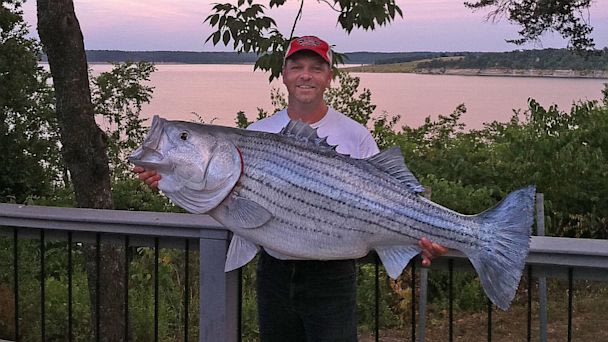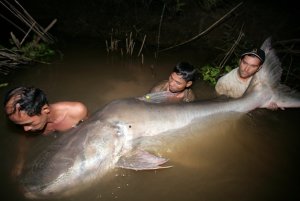I love this guy he is awesome! He goes after the worlds biggest fish and seems fearless the whole time I love his shows. Check out what live science had to say about him. I wish I had his job!!
In the slow-motion depths of Southeast Asia's Mekong River
lurks the critically endangered Mekong giant catfish, one of the world's
biggest freshwater fish. When biologist Zeb Hogan first spied this
shadowy goliath as an exchange student to Thailand in 1997, he knew he
had to learn more about them.
Since then, he's branched out and
begun studying other huge fish as a biologist at the University of
Nevada, Reno, and a National Geographic Explorer. Now, he travels the
world to find these beasts as a part of Nat Geo WILD's "River Monsters,"
which airs on Fridays. The next episode will air tonight (July 19) at
10 o'clock ET.
LiveScience's OurAmazingPlanet got Hogan on the phone to hear more about his adventures.
Livescience: What's the biggest fish you've ever seen?
Zeb Hogan: A 15-foot-long [4.6 meters]
giant freshwater stingray.
I've come across catfish in Southeast Asia that weigh 600 pounds [272
kilograms]. I've seen sturgeon that weigh 500 pounds [227 kg] and are 8
to 9 feet long [2.4 to 2.7 m].
There are about 30 species that
weigh at least 200 pounds [91 kg] and are at least 6 to 7 feet long [1.8
to 2.1 m]. I've seen 20 of these species.
LiveScience: What's your favorite fish?
Hogan: One of my favorites is the
Mekong giant catfish.
I spent about 10 years trying to tag a live one in the wild. We started
trying in 1998 and tagged our first fish in 2007. That speaks to how
rare they are. [
Photos of the Largest Fish on Earth]
LiveScience: How did you finally tag one?
Hogan: I made friends with fishermen in two areas where they are still caught regularly, in Cambodia and Thailand, on the
Mekong River. I made a deal with them that I would buy the fish off of them if they caught one; they would keep it in good condition.
They finally caught one in Thailand and we were there within 15 minutes to put a tag on the fish, and released it.
LiveScience: What's tonight's show about?
Hogan:
Green sturgeon. They occur about 100 miles [160 km] from where I live
(in Nevada). I doubt anybody has seen them, and very few people know
about them. To film one I dove about 30 to 40 feet [9.1 to 12.2 m] down,
in a current, and actually found one.
LiveScience: Have you ever felt in danger or had "close calls" with one of these fish?
Hogan: We were working on a project recently with an
arapaima,
a South American fish that weighed 200 pounds [91 kg]. They have a hard
bony head. We were trying to net it. It jumped and hit my colleague in
the chest and knocked him back. He couldn't breathe for a while or talk
the rest of the day. He thinks he broke his rib.
Some close calls
haven't had to do with the fish but being in remote areas. For example,
we were in a car crash in Mongolia while we were studying the world's
largest trout.[
Image Gallery: Freaky Fish]
LiveScience: What's the most endangered fish?
Hogan: The Chinese paddlefish may be extinct. None have been seen for several years. About 70 percent of
large freshwater fish are threatened with extinction, and they are threatened by overfishing, pollution, habitat degradation and dams.
There is a plan to
dam the Mekong that's going forward. It's a very serious threat and could conceivably cause the extinction of two of these large fish.
LiveScience: What can people do to help preserve these fish?
Hogan: I'd encourage people to learn more about the rivers and streams near them and donate to conservation organizations.
People in Las Vegas, for example, could encourage their leaders to
conserve the fish and waters of the Colorado River, which supplies the
city with water.
LiveScience: What's the weirdest of all the fish you've encountered?
Hogan: The
American paddlefish
is very strange. It has a scale-less, sharklike body and fins and a
bulbous fat body. And they have a large, frown-shaped mouth. It feeds
like a basking shark, opening its mouth and filtering out plankton. Its
paddlelike snout is covered with receptors and it has very small eyes.
It's also a very awkward fish, and can't swim well in captivity.
Another one is a goonch. There are rumors of these large predatory
catfish feeding on corpses in India. It's an unusual-looking fish with
camouflage-looking skin, brown and black, with a slender tail and long,
wispy, almost featherlike fins. A full-size one has almost nail-like
teeth, up to 1 inch (2.5 cm) long. Very small, catlike eyes.
I was snorkeling near the border of India and Nepal and saw one and dove down next to it — it didn't eat me.
LiveScience: Are they easy to approach once you find them?
Hogan:
Every species is different. Some species are very skittish. Others are
indifferent, like sturgeon. They are ancient and primitive and you get
that sense when you're in the water with them. They don't pay much
attention.
Some are curious. Arapaima will come right up to you.
It can be a little bit unnerving, a 7- to 8-foot-long fish with a
powerful mouth right in front of you — you're not exactly sure what the
intention of the fish is.
Baramundi will do the same thing — I've
been in water with them and they have a sense for where you're looking.
They come up and sit right behind your head — I'll turn around and
there's a fish a few inches away.
LiveScience: Is there ever any conflict between you and fishermen, since you are trying to save these fish?
Hogan: Not really. The fish I'm focusing on are
critically endangered
and extremely rare. For the most part, my experience in Southeast Asia
shows that fishermen get it and respect what I'm doing. "We used to
catch these all the time," they'd say, and now "we're lucky if we catch
one once per year." In Southeast Asia there's also a tradition of
sometimes releasing fish back into the river.
LiveScience: What is your proudest career achievement?
Hogan:
When I first started this work, I would be in very remote areas, like
with fishermen in middle of the night in Cambodia, catching Mekong giant
catfish. They were the only ones who saw this fish. Now, millions of
people have seen this and other fish like it.
Email Douglas Main or follow him on Twitter or Google+. Follow us @OAPlanet, Facebook or Google+. Original article on LiveScience's OurAmazingPlanet.







